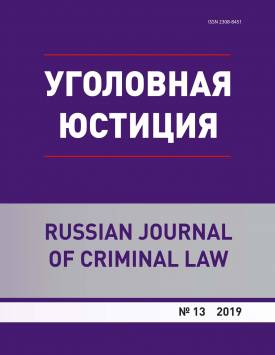The Usability of a Restorative Approach to the Implementation of Criminal Proceedings
The rule about the possibility of termination of a criminal case or criminal prosecution both at the initiative of the court and on the basis of a petition by the investigator or the inquirer but only by the court should extend to the termination of the criminal case in connection with the reconciliation of the parties. The possibility to terminate a criminal case only by the court is intended to facilitate the implementation of a number of principles of criminal substantive and procedural law: the administration of justice only by the court, the presumption of innocence, the freedom to assess evidence, the inevitability of criminal responsibility and others. Considering the prevailing court practice, as a compromise, it is possible to propose a provision in the Code of Criminal Procedure of the Russian Federation that would refer to minors who have committed a minor or moderate crime and who have not previously been convicted or released from criminal responsibility as "really first offender" rather than as "first offender". The law should secure the consent of the victim as a necessary condition for the termination of the criminal case (prosecution) on non-rehabilitating grounds. Such a proposal would balance the rights of the accused and the victim, which will have a positive impact on the implementation of the restorative approach to the administration of justice.
Keywords
восстановительное правосудие как дополнение уголовно-процессуальной формы, применение восстановительного подхода к осуществлению правосудия по делам несовершеннолетних, restorative justice as complement to criminal procedure form, use of restorative approach to juvenile justiceAuthors
| Name | Organization | |
| Noskova Elena V. | West-Siberian Branch of the Russian State University of Justice | crim.just@mail.ru |
| Shelgachev Egor M. | Tomsk State University | crim.just@mail.ru |
References

The Usability of a Restorative Approach to the Implementation of Criminal Proceedings | Ugolovnaya yustitsiya – Russian Journal of Criminal Law. 2019. № 13. DOI: 10.17223/23088451/13/15
